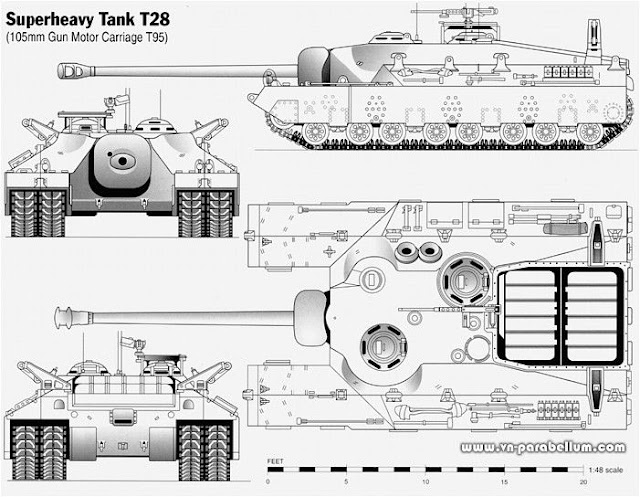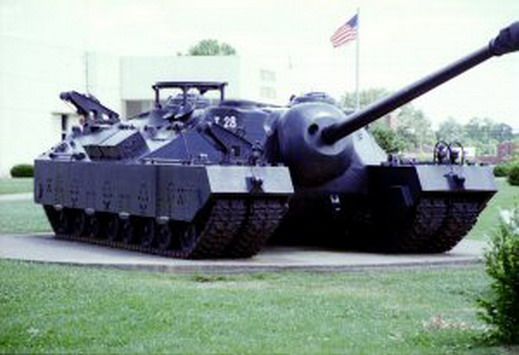Il carro Tank Superheavy T28 (poi ribattezzato 105 mm Gun motor carriage T95) è un carro armato superpesante, e fu il più pesante carro armato mai prodotto dagli USA. I prototipi furono costruiti nel 1945. Un esemplare si trova oggi a Fort Knox, nel Kentucky.
Storia
Nel 1944 l'US Army cominciò a porsi il problema di un attacco frontale alle fortificazioni della linea Sigfrido, che, date le loro caratteristiche, richiedevano un veicolo che fosse provvisto contemporaneamente di un armamento di calibro elevato e di una blindatura estremamente elevata. La necessità di soddisfare contemporaneamente a questi requisiti portò alla progettazione di un veicolo (nella denominazione statunitense era "tank", cioè carro armato, ma in realtà si trattava di un semovente d'assalto) privo di torretta ed armato con un cannone 105 mm T5E1 lungo 67 calibri.
Data la necessità di avere i veicoli a disposizione in tempi brevi furono utilizzate, per quanto possibile, parti già in produzione o almeno in progetto, tuttavia il primo veicolo non fu disponibile che verso la fine del 1945. Il mezzo aveva una blindatura frontale di 1 ft (305 mm), massima corazzatura mai realizzata su un veicolo blindato. Il peso totale del veicolo raggiunse le 84 t, quindi, per avere una pressione al suolo sufficientemente bassa, era necessario utilizzare cingoli di una notevole larghezza. Di conseguenza, per poter limitare la larghezza del mezzo in modo da permetterne il trasporto su carri ferroviari ed il passaggio attraverso strettoie, furono realizzati cingoli in due sezioni affiancate, in modo da poter ridurre la larghezza su strada. Le due sezioni esterne, quando erano smontate, erano affiancate e trainate dal mezzo.
L'armamento principale era su un cannone da 105 mm T5E1 su affusto T40, con una velocità alla bocca di 1100 m/s (3700 ft/s) per i proiettili perforanti ed una gittata di 19000 m (20750 yd).
L'armamento secondario era composto da 2 mitragliatrici Browning M2 da 12,7 mm.
La corazzatura era in acciaio fuso per la parte frontale e in lamiere per le fiancate, avevano spessori di 102-90mm.
ENGLISH
The T28 Super Heavy Tank was an American heavily armored tank/self-propelled gun designed for the United States Army during World War II. It was originally designed to be used to break through German defenses of the Siegfried Line, and was later considered as a possible participant in the planned invasion of the Japanese mainland.
The 100-ton vehicle was initially designated a heavy tank. It was re-designated as the 105 mm Gun Motor Carriage T95 in 1945, and then renamed in 1946 as the Super Heavy Tank T28.
Only two prototypes were built before the project was terminated.
Name
Initially named Heavy Tank T28 when construction was authorized in 1944, the design did not fit in the usual categories of vehicles leading to reclassification. As it did not have its armament in a revolving turret, Ordnance requested a name change to 105 mm Gun Motor Carriage T95, the change becoming official in March 1945. However, due to its heavy armor and armament—while self-propelled guns in United States service were lightly armored—it was renamed Super Heavy Tank T28 in June 1946 by OCM 37058.
Development
The T28/T95 was designed to be used for attacking the heavy defenses expected of the German Siegfried Line. The 105mm T5E1 gun selected was known to have very good performance against concrete and "expected to be extremely effective at reducing heavy fortifications" After the vehicle passed trials, the German Siegfried Line had already been infiltrated and overwhelmed by the allied forces, so the designers decided to have the T28/T95 tanks to fight on the Japanese mainland later in the war. Japan surrendered before the tank was able to be transported overseas.
The need for an assault tank was first identified in 1943, Ordnance proposing that 25 vehicles could be ready for operations. A conference in March 1944 between Ordnance Department and Army Ground Forces resulted in agreement to build five. The Pacific Car and Foundry Company were supplied with the design in March 1945, completed final design and had the first hull welded by August. By the time the first tank was completed and ready for combat, the war was over. The plan for five was reduced to two.
As it did not have a turret, but a fixed casemate mount instead for its main armament (as German Jagdpanzers and Soviet Samokhodnaya Ustanovka-designation combat vehicles did), and the 105 mm gun fitted could only elevate from 19.5° to −5° and traverse from 10° right to 11° left of the centerline, the T28/T95 more closely resembled a self-propelled gun, and was redesignated as "T95 Gun Motor Carriage" in 1945, but in June 1946, the vehicle was redesignated again as "Super Heavy Tank T28".
Two prototypes of the T28 were built. They underwent evaluation at the Aberdeen Proving Ground and Fort Knox facilities until 1947. In 1947, one of the T28s was heavily damaged by an engine fire during trials at Yuma Proving Ground and was broken up and sold for scrap. The T28 never went into service due to the obsolete design, expensive maintenance costs, and the heavy weight, which prevented it from being transported across seas, but was retained to test the "durability of components on such a heavy vehicle". Work on it ended before completion as the War Department decided to stop the development of vehicles of that sort of weight and the T28 program terminated in October 1947. By that point, the T29 and T30 turreted heavy tank designs had been built. The T29 mounted the same gun as the T28 in a conventional rotating turret. The T30 was developed with a larger-caliber gun and more powerful engine. The T29 program was used to test mechanical components for future tank designs.
Surviving vehicle
In 1974, the last prototype was discovered abandoned in a field at Fort Belvoir, Virginia. Camouflaged in the middle of some bushes, it is unknown where it spent the intervening 27 years. It is the sole remaining example of these tanks and was exhibited at the Patton Museum of Cavalry and Armor in Kentucky. In 2011, it was shipped to its new home at Fort Benning, Georgia. It was placed in the new Patton Park, which is a plot of 30 acres where all of the tanks being stored at Fort Benning are now displayed. Unfortunately, the vehicle was damaged in January 2017 during transit to another facility for external refurbishment when it broke loose from the M1070 HET carrying it. The transporter failed to negotiate a downhill slope and subsequent turn at a safe speed, causing the securing chains to break and allowing the T28 to slide off the trailer. Despite then rolling into a ditch, only minor repairable damage was sustained to two bogies. The outer track units had been removed.
Design
The mechanical superstructure was taken from a T23. The original plan was to build five prototype vehicles, with a production total of 25. Its total weight when fully equipped would have reached 95 short tons (86 tonnes). To lower ground pressure, instead of two tracks, it used four tracks that projected forward of the hull, each 12.9 inches (328 mm) wide. The outer tracks could be detached within two hours for rail transport: After removal, they could be fixed together to make a unit that could be towed behind the tank. Due to its extreme weight and low engine power, the T28 had extremely limited obstacle-crossing ability and could not cross any of the portable bridges available at the time, and so was considered impractical in the field and not suitable for production.
The T28 had no conventional turret, with a casemate style hull instead, giving it a comparatively low profile, as the later examples of the fully enclosed Jagdpanzer-family of German tank destroyers, not entirely dissimilar to the 50 short-ton weight German Jagdpanther. Its main armament was a 105 mm T5E1 gun, in a ball-shaped gun mantlet set into the vertical hull front. The traverse was limited to 10° right and 11° left, and elevation from 19.5° to −5°. When traveling, the gun was locked at the maximum elevation. The only other armament was a .50 cal. (12.7 mm) M2 Browning machine gun on a ring mount above the commander's hatch for anti-aircraft use. The main gun—65 calibres long—had a muzzle velocity of 3,700 feet per second (1,130 m/s), with a range of up to 12 miles (19 km).
The armor was very thick compared to other tanks of the time, up to 12 inches (305 mm) thick on the front. This was considered heavy enough to provide protection from the German 88 mm gun used as tank and anti-tank guns. The lower hull front had 5.25 in (130 mm) of armor, and the sides 2.5 in (64 mm). The suspension system and lower hull were covered with 4-in (100 mm) thick steel skirts. The engine was a gasoline-powered Ford GAF V-8, delivering 500 hp, at 2600 rpm through the Torqmatic transmission; which left the vehicle underpowered, geared down to a top speed of about 8 mph (13 km/h) and greatly limited its obstacle-climbing capability.
Popular Culture
The T28, or T95 GMC has been affectionately nicknamed the "Doom Turtle" among online historical tank game communities but in WOT its called the "zoom turtle" after its top speed was increased. The armor of the tank is a metaphorical shell, while the limited gun traverse of the vehicle armament metaphorically refers to the fact that a turtle is unprotected from the back, the low speed of the tank makes it comparable to a turtle.
(Web, Google, Wikipedia, You Tube)















































































